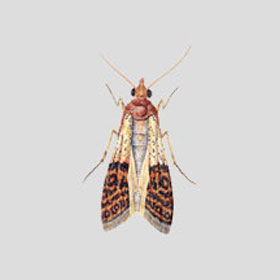Stored Food Pests Come Prepackaged!
By Chris Williams on May 24, 2013.
 Question
Question
When we were in New Mexico last summer, I bought a cellophane bag of dried hot peppers from a roadside stand to bring home. I stuck them on a top shelf in the kitchen and forgot about them. When I pulled them out this morning, there were several dead moths inside the bag. The bag is still unopened. How did the moths get in there? I hate to think that there were moth eggs in the bag when I bought it!
Answer
The bag probably did contain eggs, or larvae so small you couldn’t see them, when you bought it. You don’t describe the moths but the best guess is that they are Indianmeal moths. Indianmeal moths are probably our most common stored food pest in homes. They feed on a wide variety of dried and packaged foods, including dried peppers.
There’s a slim chance that you already had Indianmeal moths in your kitchen and that a female moth laid her eggs on the dried pepper bag. The larvae that hatch can chew a tiny hole in the bag to get inside to feed on the peppers. Odds are much better though that an Indianmeal moth in New Mexico laid eggs on the peppers during the drying process or before they were packaged.
Indianmeal moth adults are about ½ inch long, and light gray with a broad copper-colored band across their wings. The eggs hatch into whitish larvae that feed on the food product, spin silk webbing, and grow to about ½ inch long before they pupate in a cocoon. If you look closely at the bag, you will probably see more evidence: shed larval skins, pupal cocoons, feces, and dried pepper dust in the bag.
If you have reason to believe that the moths were confined to the bag (you don’t see any holes or tears in the bag and there is no debris on the shelf under the bag), there is no reason to do anything except dispose of the bag.
This is why we remind customers to periodically check those items that are way on the top or way in the back on their kitchen or pantry shelves. Stored food pest infestations usually start in those packages that are the oldest, that are past their “use by” date, that have been damaged, or that have gotten damp or moldy. You should always practice the principle of FIFO, “first in, first out,” which means you should rotate packages on your shelves so that the oldest items get used first.